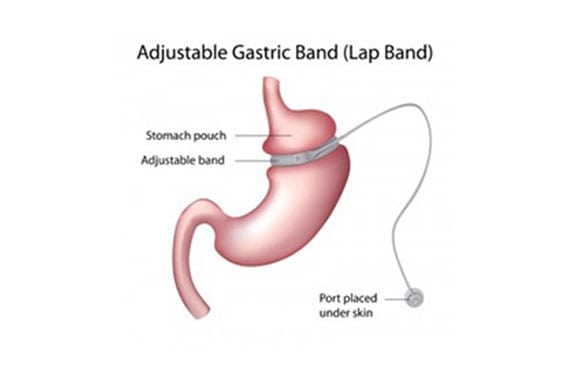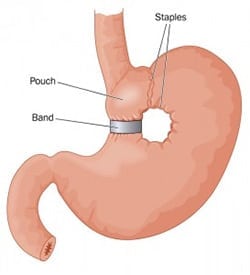
Let Revision Bariatric Surgery put you back on the right track.
Revision bariatric surgery is a procedure performed on those who have already undergone some form of bariatric surgery. Typically, the surgical procedures for revision are performed using a laparoscopic approach, however, if your initial surgery resulted in excessive scarring an open surgery may be necessary.
- There are many reasons why you might need a revision, but it is not a sign that your procedure has failed
- Many patients continue with their success after a revision procedure
When Is Revision Bariatric Surgery Necessary?
A revision of your original bariatric surgery may be necessary if you have had post-operative complications, have failed to achieve significant weight loss, or if you have gained back a large percentage of weight lost.
The reasons a revision bariatric surgery may be necessary may include the following common reasons:
- Difficulty swallowing
- Limited dietary choices
- Heartburn
- Lap-Band slip
- Lap-Band erosion
- Dilation of gastric pouch (increased stomach size)
Evaluating Need for Gastric Bypass Revisions
 The most common reason for gastric bypass revision is the dilation of the gastric pouch, meaning an increased stomach size resulting in insufficient weight loss or too much weight gain. During the initial gastric bypass procedure, your stomach is reduced to approximately 20 percent of the original size. Unfortunately, if the proper aftercare is not taken the size can increase, as the stomach is a flexible organ, which can result in greater food intake.
The most common reason for gastric bypass revision is the dilation of the gastric pouch, meaning an increased stomach size resulting in insufficient weight loss or too much weight gain. During the initial gastric bypass procedure, your stomach is reduced to approximately 20 percent of the original size. Unfortunately, if the proper aftercare is not taken the size can increase, as the stomach is a flexible organ, which can result in greater food intake.
Prior to performing a gastric bypass revision, your surgeon will want to rule out problems related to diet and exercise. You will likely work with a dietician to use a diet journal to track what you eat, or a psychologist to rule out emotional issues that may be affecting your diet.
To rule out exercise as a cause, you may need to work with a dietician who will utilize a special device to test your basal metabolic rate (BMR). This is the amount of energy you burn while at rest. This is because those that have a very low BMR may have difficulty losing weight, even if there are no issues with your stomach size and diet. If a low BMR is determined to be a problem, you will likely have to change your exercise habits as your BMR can be increased by adding lean muscle.
After your surgeon rules out diet and exercise problems, he will need to assess the size of your stomach and the opening between your stomach and small intestine (stoma) as these may be the cause of weight loss problems if they are too large. To do this, there are various tests your surgeon may perform. These may include:
- Eating Test – The amount of food you eat before feeling full will be measured by your surgeon.
- Endoscopy – During this procedure, a tube with a camera is passed through your mouth, down your esophagus, and to your stomach to assess the size of your stomach and stoma.
- Upper Gastrointestinal Tract Radiography – To assess movement within your digestive tract, your surgeon will have you drink a colored dye while performing an x-ray.
Types of Gastric Bypass Revisions
 Your surgeon will choose which type of revision bariatric surgery is necessary to achieve weight loss success by reducing the size of your stomach or stoma. If your stomach size is reduced, you will feel full more quickly as your stomach will hold less. If your stoma is reduced, you will feel full for a longer period of time as your stomach will drain more slowly. Types of these revisions include the following:
Your surgeon will choose which type of revision bariatric surgery is necessary to achieve weight loss success by reducing the size of your stomach or stoma. If your stomach size is reduced, you will feel full more quickly as your stomach will hold less. If your stoma is reduced, you will feel full for a longer period of time as your stomach will drain more slowly. Types of these revisions include the following:
- Shrinking the Size of the Stoma – During this procedure your surgeon will inject sodium morrhuate into your stoma. A course of two or three procedures may need to be done for the injections. The idea is to create scarring that will decrease your stoma.
- Lap-Band Surgery – This procedure involves the addition of an adjustable band around the top part of your stomach to reduce stomach size to a one to two-ounce pouch.
- Lengthening of the Roux Limb – This gastric bypass revision is typically considered for those who have a low basal metabolic rate and continue to have poor weight loss results, despite changing exercise habits. This procedure converts your conventional Roux-en-Y bypass from a conventional or proximal type to a distal type. This means bypassing a larger portion of your intestines.
- Conversion to Duodenal Switch – Those who require a revision bariatric surgery, especially those who had an initial body mass index over 50, can greatly benefit from this procedure. This is another type of malabsorptive procedure such as the Roux-en-Y. During the Roux-en-Y procedure, a portion of the stomach is used to create a small pouch equivalent to the size of an egg. The small intestine is attached in a manner that bypasses the remaining portion of the stomach, and the portion of the small intestine known as the duodenum, thus, the process of digestion is altered. During a duodenal switch, the stomach size is greatly reduced by removing approximately 75 percent of it, and the small intestine is reattached to the remaining stomach portion in a manner not to bypass the duodenum, therefore not affecting the process of digestion.
Evaluating Need for Lap-Band Revisions
 The Lap-Band is a restrictive type of gastric surgical procedure. Those that initially had the Lap-Band procedure and experienced excellent results may be good candidates for an additional restrictive procedure, such as the gastric sleeve. This is suggested when the Lap-Band failed for technical reasons and was not related to a problem with restriction.
The Lap-Band is a restrictive type of gastric surgical procedure. Those that initially had the Lap-Band procedure and experienced excellent results may be good candidates for an additional restrictive procedure, such as the gastric sleeve. This is suggested when the Lap-Band failed for technical reasons and was not related to a problem with restriction.
Those that did not achieve weight loss or improvement in health with the initial Lap-Band procedure may be candidates for gastric bypass, which is a malabsorptive procedure.
Types of Lap-Band Revisions
If your surgeon has determined that you are a candidate for a restrictive revision surgery, he will need to determine which of the available options are best for you. These options include the following:
- Rebanding – This procedure involves the removal of your initial band and replacing it with a new one.
- Surgery to Revise Lap-Band to Gastric Sleeve – The gastric sleeve is also a restrictive procedure, however, it involves the removal of 60 to 80 percent of your stomach only leaving a narrow tube. Weight loss following this revision surgery may be as high as 60 percent.
- Surgery to Revise Lap-Band to Roux-en-Y Gastric Bypass – This converts your initial restrictive procedure to a malabsorptive procedure. Available research reports that weight loss using this type of revision bariatric surgery may be as high as 70 percent.
- Surgery to Revise Lap-Band to Duodenal Switch (DS) – The DS is another type of malabsorptive procedure.
Prior to Revision Bariatric Surgery
 Although there are many advantages of having revision bariatric surgery, it is still a procedure that comes with its own set of complications and risks. Be sure your surgeon has advised you of these.
Although there are many advantages of having revision bariatric surgery, it is still a procedure that comes with its own set of complications and risks. Be sure your surgeon has advised you of these.
Also, prior to undergoing an additional bariatric surgery, your surgeon needs to determine that a revision bariatric surgery will likely be effective based on many factors such as weight loss, diet, and initial surgical outcome. To help your surgeon make this determination you should be prepared to provide the following information:
- The date of your initial bariatric surgery.
- The location of your initial procedure.
- The instructions that you were given after your initial surgery.
- The amount of initial weight loss following your bariatric surgery.
- Any complications you endured following the initial surgery.







